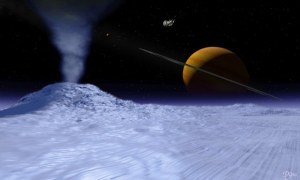 Artist concept of a geyser erupting on Enceladus.
Artist concept of a geyser erupting on Enceladus.
Credit: David Seal.Back when I was young...okay, a previous generation might have ended that sentence with, "…I’d walk forty miles through the snow to get to school…" But I'm not exaggerating when I say, when I was young we knew next to nothing about faraway places in the Solar System…such as the moons of Saturn.
A layer of the veil around Saturn’s moons was removed when Pioneer 11 and Voyagers 1 and 2 made flybys of Saturn in the '70s and '80s. The Saturnian moons, it appeared, were not the lumps of rock and dust that Earth's own Moon is made of, but objects containing no small amount of water ice. Not terribly surprising, considering the low temperatures of the outer solar system where ice-rich comets roam.
Visions of frozen alien landscapes, replete with icicles and ice cliffs and ice fields and ice ice ice! were conjured in my imagination, and in artist depictions of majestic ringed Saturn seen from moons like Rhea or Dione or Enceladus.
Four years ago, Saturn’s first permanent visitor from Earth--the Cassini spacecraft--arrived there, and since has been making extreme closeup examinations of Saturn, its rings, and its increasingly wondrous and beautiful moons. Cassini is almost literally ripping apart veil after veil of our ignorance of these little worlds.
Far from a contingent of enormous but simple snow cone balls, Cassini has shown us that some of Saturn’s moons are apparently alive with liquid motion. First, there were the surface “lakes” and “seas” on Titan, probably made of extremely cold liquid hydrocarbons like methane and ethane--the stuff that spouts out of the gas range in your kitchen. Lakes and seas and rolling waves of liquid natural gas are fine and dandy for an imagined shoreline scene--but take a dip in those "waters" and an actual water-based creature like you would freeze solid in seconds. Scenic, but not inviting for a swim…
